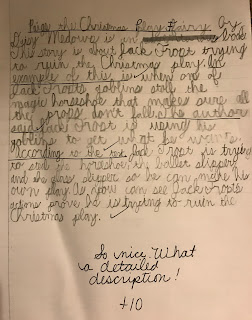*Increase the time students spend actually reading and writing!
*These rigorous, differentiated, prompted reading responses will train your students to write strong, well-supported paragraphs showing their understanding of their reading.
*With these reading response prompt forms students write about whatever book they are currently reading (fiction or non-fiction)- increasing choice- increasing engagement!
*They learn to write one well-developed paragraph using a hook, topic sentence, and supporting sentences.
*Each of the four forms has a slightly more advanced structure guiding them in paragraph creation.
*These rigorous, differentiated, prompted reading responses will train your students to write strong, well-supported paragraphs showing their understanding of their reading.
*With these reading response prompt forms students write about whatever book they are currently reading (fiction or non-fiction)- increasing choice- increasing engagement!
*They learn to write one well-developed paragraph using a hook, topic sentence, and supporting sentences.
*Each of the four forms has a slightly more advanced structure guiding them in paragraph creation.
This started for me last summer. With the goal in mind of increasing the time my students (3rd graders) spent actually reading and writing, I knew I wanted to incorporate reading responses into my classroom routine. After reading Donalyn Miller’s books (if you haven't read them and you are a teacher- go straight to the library!), Book Whisperer and Reading in the Wild, I became passionate about finding an age-appropriate but rigorous method to train my kiddos to write about their reading.
Thus were born, these prompted reading responses. There are 4 forms. I use one form per quarter during the school year, but you could use them to differentiate giving kids the form they are ready for. You could skip right to form 3 for 4th graders, or stay on form 1 and 2 for 2nd graders. By third quarter, or form 3, I have the students use the form as a guide, but don’t require they write directly on it. I have them write their responses in a spiral notebook. If they can use the form to write a strong paragraph, mission accomplished.
The students use the guided forms to help them write a reading response. This became weekly homework for my class, but it could be in-class work as well. They write about whatever book they are already reading, at whatever spot they are already at, fiction or nonfiction. They write one well-developed paragraph using a hook, topic sentence, and supporting sentences. Each quarter has a slightly more advanced form guiding them in paragraph creation. You can have your students simply fill out the form, or take what they’ve written on the form and write it in an actual paragraph (I recommend moving towards this). I have my kiddos write this in a notebook.
We also used these entries in class for oral book commercials- advertising the books aloud to each other. I used this product with my class last year, and after 14 years in the classroom, I've never had a class more excited about reading each other's favorite books and sharing great reads with each other!
I feel like reading responses help me (and the parents, if you’re using it for homework) keep track of what the kids are reading, the progress they are making, the rate of book completion vs. abandoning books. The students get an increased amount of practice in paragraph construction, summarizing, and applying skills from class (using ‘exciting’ words, varying sentence length, adding description, etc). Students have to focus on their own comprehension, knowing they are going to write about what they are reading. It also excited many to read their book and then write, knowing that their audience would respond (my reading and responding to their entries and then the oral book commercials with their classmates responding). It sets a purpose for their reading (“I haven't written about setting in awhile, I should pay attention to information about the setting today and write about that.”). It helps me check their level of understanding as they are reading... “Are they totally missing the main themes of the book? Are they only picking up on surface level information? Is setting all they ever what to write about?” It increases opportunities for reading and writing and builds the connection between the two- my original goal.
The difference in the writing samples from the beginning of the year to the end are dramatic and impressive. Here’s a real 3rd grade student example from the first quarter of our school year.
I enjoyed Charlotte's Web by E.B White. One of the characters is a spider named Charlotte. Charlotte saved Wilbur's life. She wrote words in the web so the people thought the pig did it.
Here’s a real 3rd grade student example from the end of the year:
I am enjoying The Most Magnificent Thing by Ashley Spires. The story is about a little girl who has a wonderful idea. She has a dog that is her assistant. According to the book the little girl knows exactly what she wants to make. She knows exactly what it should look like and how it should work. She does not know how she will make it and she has tried many times and has failed. She is now mad and explodes in anger. The book said it’s not her finest moment! After she calms down, she gets a vision how to make it using all of the other parts that she made and failed.
I used this strategy with my students all last year and got some amazing results, not just what I saw in class, but with the growth they made in our benchmark testing. If you teach reading grades 2-4, I hope you'll come take a look. This is my first paid item, but I priced it nice and low because I genuinely do want teachers to be able to use it. If you like it as much as I do, please let me know!







No comments:
Post a Comment